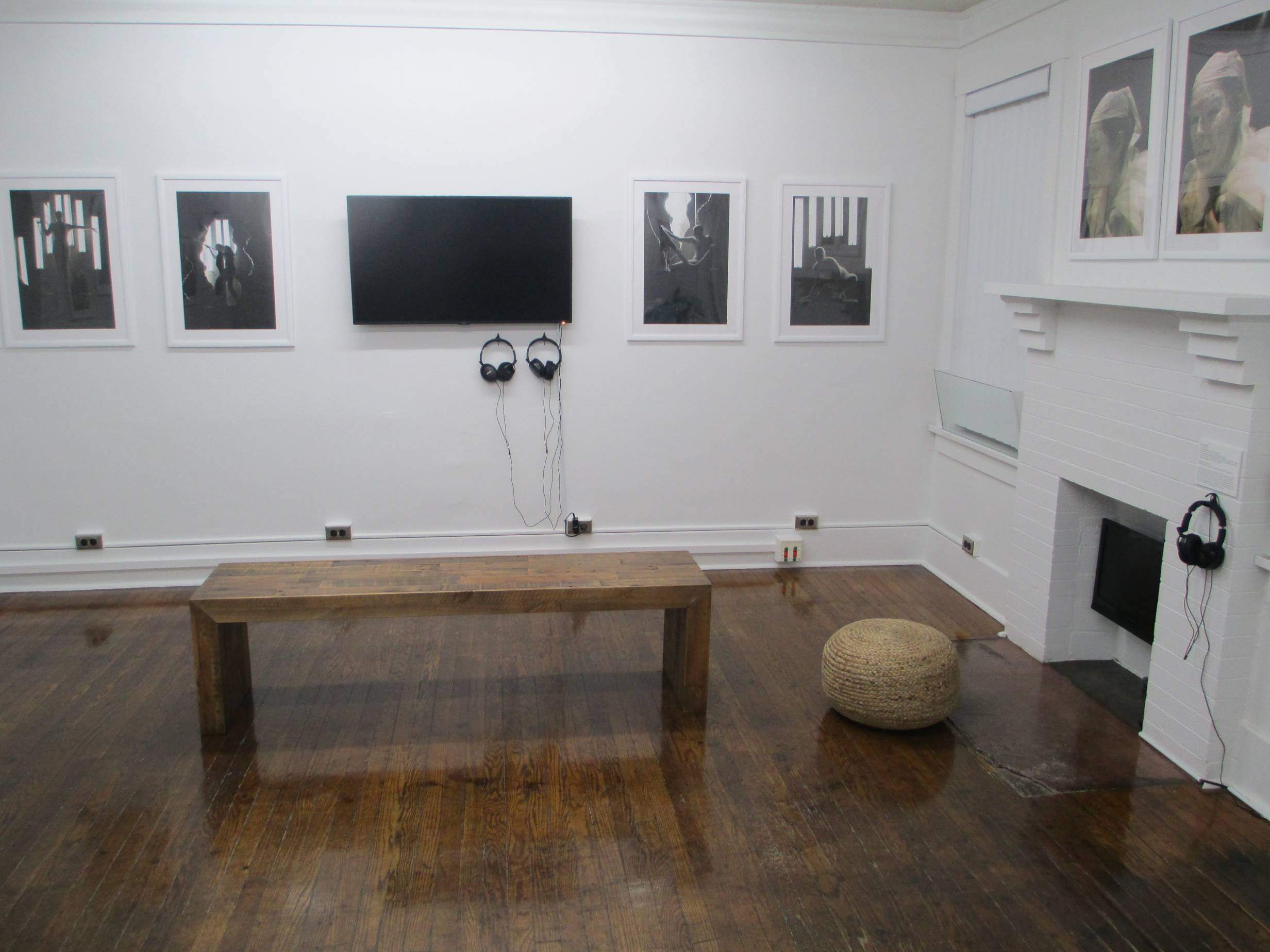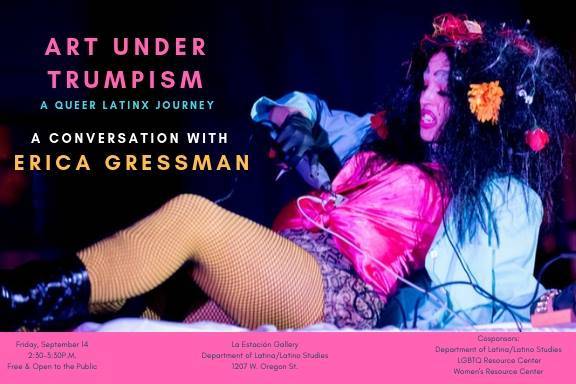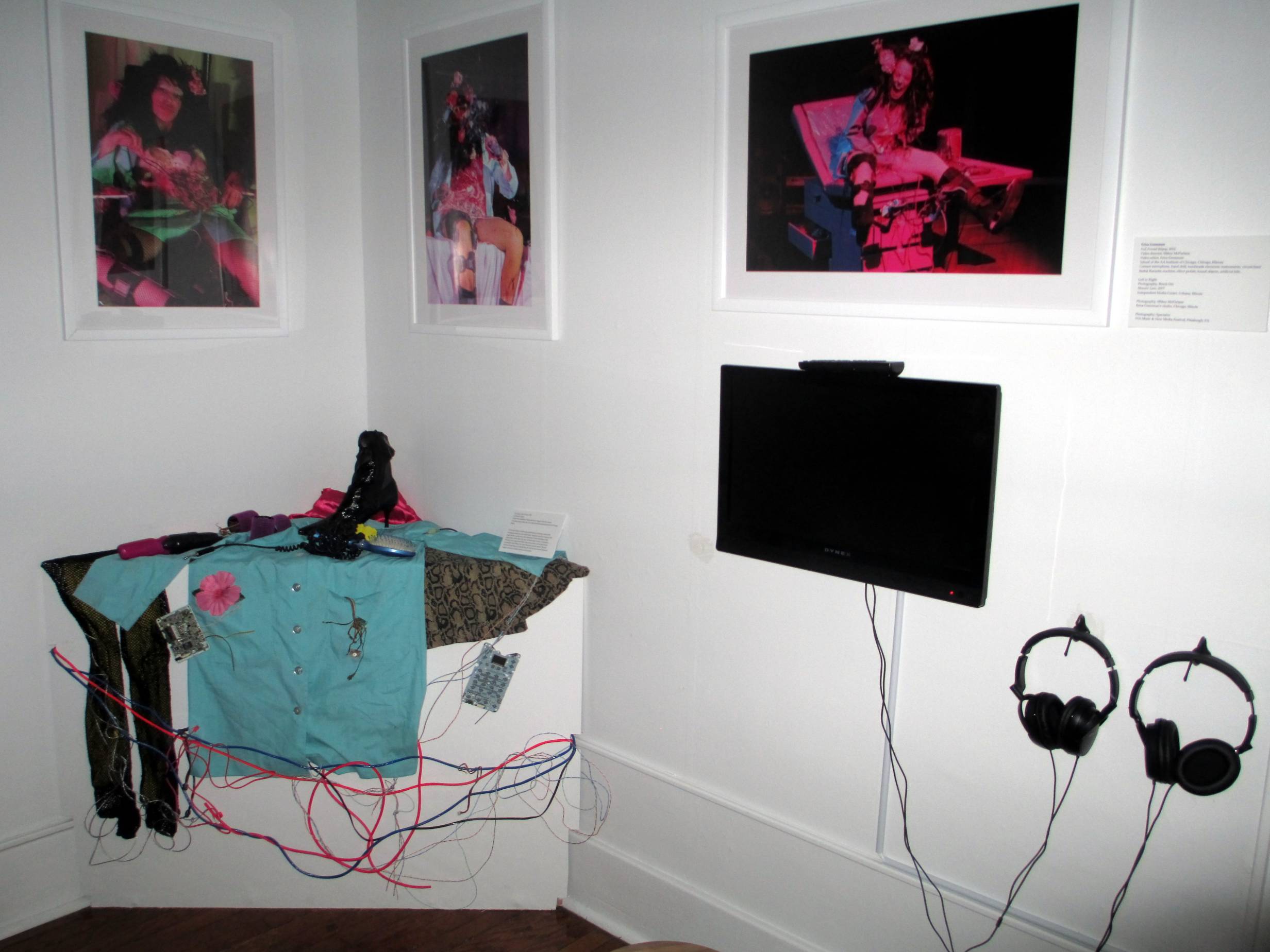The Department of Latina/Latino Studies (LLS) is hosting their inaugural artist-in-residence this year: Erica Gressman. La Estación Gallery, a new performance/art gallery on the first floor of the LLS building, will present Gressman’s first solo exhibition, Limbs, Ligaments, Parts: My Body is There.
During the opening reception on September 12th, Gressman will lead a talk-and-tour of her exhibition on queer Latinx art. This interactive exhibition covers almost a decade of her work, including photography, musical scores, videos, and sensory installations. The exhibition highlights how the artist turns to the posthuman to explore issues of difference across identity markers. Along with the exhibition opening, Gressman will also be premiering her performance Limbs at the Krannert Art Museum on Thursday, September 13th. Limbs involves a metal cage doubling as a large-scale sound instrument. Violin-like electronic sounds will be controlled by Gressman’s body moving within the cage and through the removal of limbs, ligaments, body parts, and multiple-heads. The performance will be followed by a conversation with the artist, Dr. Joshua Chambers-Letson, Dr. Fiona Ngô, and the organizer of these events, Dr. Sandra Ruiz. The first week of this residency will end with a conversation with Gressman on Friday, September 14th at the LLS building, where she’ll discuss the challenges of being a queer Latinx performance and noise artist in the Trump era in “Art Under Trumpism.” All events are free and open to the public (find the details at the end of this article).
Gressman performed Wall of Skin in 2016 at the Department of Latina/Latino Studies inaugural “Being Brown, Being Down: Performances of Spic and Span” symposium. Her return marks an important shift in programing at the University of Illinois, the Department of Latina/Latino Studies, and the Krannert Art Museum — that is, the inclusion of minoritarian and experimental performance in galleries and other nontraditional or DIY performance spaces on campus. Gressman’s performance of Limbs was organized and curated by Assistant Professor of Latina/Latino Studies and English, Dr. Sandra Ruiz, with Amy L. Powell, curator of Modern and Contemporary Art at Krannert Art Museum.
Gressman’s multidisciplinary and experimental art tears down disciplinary walls between the theoretical, political, and aesthetic, between avant-garde performance and ethnic studies, and between the strict codes that govern identity and one’s refusal to abide by them.

Not only is this evidenced in the work itself and by the copious support from departments across campus, but also in the significance of an ethnic studies department hosting an artist-in-residence in experimental art in their own building and gallery. This gallery also provides a performance curation internship opportunity to students and former students in LLS and across campus.
I interviewed the designer and curator, Dr. Sandra Ruiz, to learn more about what this residency means to her, to Latina/o/x Studies, the campus community, and to the future of teaching, learning, and knowledge production.
Smile Politely: What does this project mean to you and what is your role in it?
Sandra Ruiz: I think there are several components to La Estación Gallery — the creation of the space; the politics underpinning its production; and the educational initiative advancing the internship in performance curation and arts management for students in Latina/Latino Studies. I have a PhD in performance studies and with that training comes a diverse set of methodological tools that I enact in order to do aesthetic and theoretical labor. I’m not alone here; there are a lot of us on campus trying to figure out how we can do performance studies on a campus that doesn’t have a performance studies department, and to do it well; that is, to engage the genealogical and ontological threads of the field. That’s one of the motivating questions for creating La Estación Gallery — to bring practices of performance studies to the forefront. But another important component of this belongs to the relationship between aesthetics and politics within an ethnic studies department, specifically what it looks like when ways of thinking and doing are not grounded in only empirical evidence or folkloric traditions.
My ethnic studies is relational, experimental, post-intersectional, futuristic, and creative, moving us in a direction that allows us to land in a future that never wanted minoritarian subjects to land, let alone experimental subjects and their art practices. In thinking of how our students could benefit, particularly students in LLS who are not familiar with different art practices, but are curious, we decided that turning an atypical space into an aesthetic site would be the best way to build an undercommons built by the hands that need it most. So much of this gallery is about people coming together and place-making from the ground up — a collective labor that ensued tremendous public engagement, growth, and vision. It’s a gallery that will house and fund working artists, and it feels incredibly important that this is happening in an ethnic studies department that welcomes them.
SP: And also that it’s being spearheaded by queer women and women of color.
Ruiz: That’s absolutely right. It’s being run by queer women, queer women of color, and women of color who are doing this as a labor of love and commitment to collective action and aesthetic expansion. But we aren’t the first. We, too, are following in the footsteps of women of color and queer women of color who have paved the way. Many of the artists who will have a solo exhibition in the gallery will be queer, women of color, people of color working at the edge of experimentation, helping us to rethink existence through creative innovation. This requires that those of us working in ethnic studies remain attentive to the concerns of gender, sex, and sexuality in all of the work we do, not just the designated thinkers that help us locate these markers of difference. This also means that institutional sites like museums remain accountable to us, too; that is, how we are represented within and against their walls.
I have to say that I am really excited by the gallery internship. It has already started engaging graduate and undergraduate students across campus. Our interns are fabulous. They are learning about performance curation, arts management, how to work creatively as well as administratively. Some of the interns are in charge of social media, so they’ve created the Facebook page, the Instagram page, a website; others are shadowing the project and writing pieces about what’s happening and why it matters; some of the other interns are working on grants and proposals, others are assisting in installation, so it’s a pretty multi-faceted internship that is allowing our students to be agents of their own knowledge. The creation of this internship was Alicia P. Rodriguez’s idea, who figured if students were already doing the work just because they loved doing it, they should receive credit for their labor and help run the space, and also have the internship function as an opportunity in professionalization and guided research.
SP: I remember in an earlier conversation you mentioned that this had implications for the larger Urbana Champaign Community.
Ruiz: Placing pressure on established fields of thought is always needed for any discipline, institution, field, community to move into the future. And I think that that’s what someone like Erica Gressman’s work does: She forces us to be curious in ways that allow us to respect difficult art without shutting down different ways of being brown, queer, Latinx, human. She forces us out of the transparency binds of race, gender, sexuality, and ethnicity by making us accountable to them, by working with, through, and against them. She forces us to see that we have always been experimental, abstracted as queers and people of color. Opening with Gressman’s exhibition is important: Her work is challenging, odd, and it’s going to force us as spectators to be patient, to lend a different type of ear and set of eyes in order to understand the work. That’s important for me as someone who writes about minoritarian aesthetics and privileges the experimental, but also super important for the fascistic times we are living under, in which fake news, daily scandal, an adamant distaste for thinking and innovation seem to get humans punished and killed. Part of rethinking dangerous authority is to rethink place and place-making from the inside out. This is my idea of public engagement.
As an ethnic studies and performance studies scholar, these modes of thinking, doing, engaging always exist simultaneously. From the beginning of this initiative we’ve been in conversation with the Krannert Art Museum. They’ve been extremely supportive of the gallery, of bringing minoritarian performance into their gallery spaces over at the museum, too. In all of these curated events, funded by many units across schools, I hope to share with the public what it means to engage performance art and curation critically, strategically, respectfully, and how we can continue to create dialogic encounters between experimental aesthetics and ethnic studies on this campus.
Limbs, Ligaments, Parts: My Body is There
La Estación Gallery
1207 W Oregon St
Urbana
Opening reception with talk-and-tour: Wednesday, September 12th, 5:30 to 7:30 p.m.
Limbs Performance
Krannert Art Museum
500 E Peabody Dr
Champaign
Performance and panel discussion: Thursday, September 13th, 7:30 p.m.
Art Under Trumpism: A Queer Latinx Journey
1207 W Oregon St
Room 105
Urbana
Friday, September 14th, 2:30-3:30 p.m.
Photos courtesy of the Department of Latina/Latino Studies








